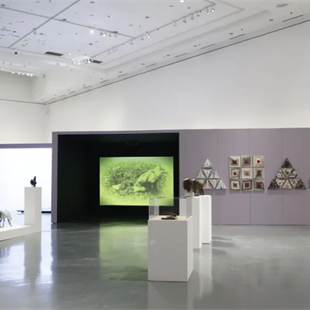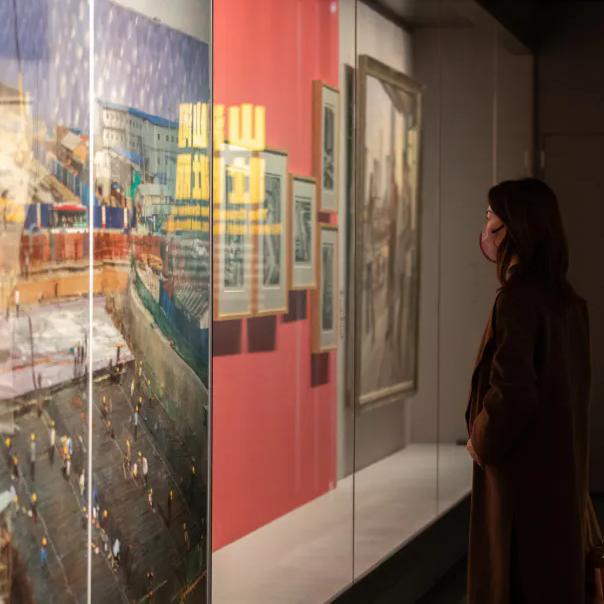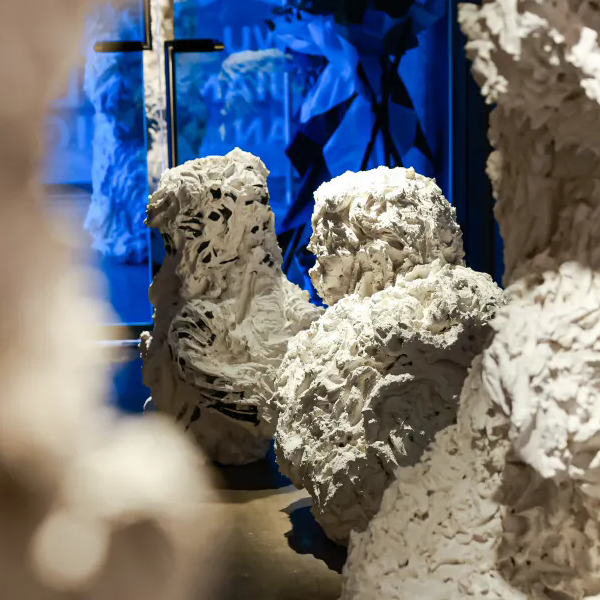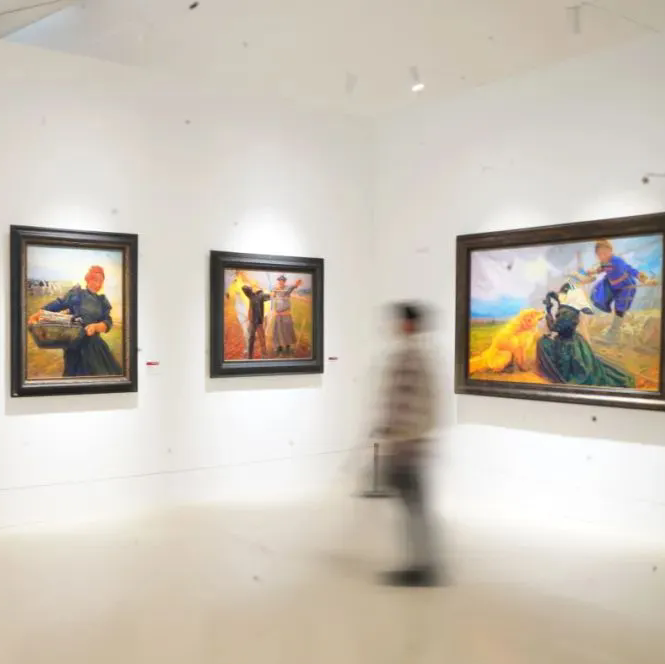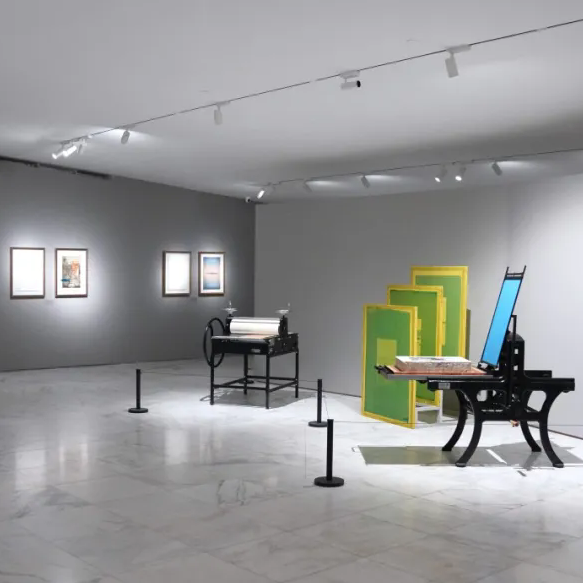Geng Jianyi: Questions Concerning Art and Expression
From November 10, 2022, to February 12 2023, Power Station of Art hosts the exhibition “Who is He?”, a retrospective exhibition of the work of Chinese artist Geng Jianyi, one of the most influential artists of his generation. The exhibition is curated by Karen Smith and Yang Zhengzhong.
Geng Jianyi became widely known first in 1985 as he graduated from the oil painting department of China National Academy in Hangzhou. In particular, his graduation painting Two People Under a Light challenged the idea that narrative meaning was the ultimate goal of an artist’s intent, or was the sole purpose of artistic expression. Building on this concept, through the course of the coming three decades, Geng Jianyi engaged in a diverse range of activities aimed at exploring what the real purpose of art could be. Numerous of these activities took simple acts of daily life as the content and form of artworks that Geng Jianyi hoped would make the audience think about the different ways in which art can be understood. To illustrate this further, he worked with multiple media and techniques, re-imagining painting, print-making, video and photography, performative and conceptual practices in distinctly innovative ways.

Geng Jianyi, “Who Is He?”, 1994, 26 pieces, comprising written statements, drawings and photos, A4. Collection of Kroller-Muller Museum, Otterlo, The Netherlands.
The title of the exhibition, “Who is He?”, is the title of an important conceptual work that Geng Jianyi produced in 1994. “Who is he?” was the question instinctively asked when a visitor called at Geng Jianyi’s home in his absence. To uncover the identity of the mysterious “he”, Geng Jianyi turned to his neighbours to learn what they had observed of the stranger. The resulting artwork comprises the drawings and written descriptions they provided. In terms of this exhibition and its title, the curators take the question “who is he?” as a means of describing “who is Geng Jianyi”, as reflected through the distinctive character of Geng Jianyi’s artistic practice.

Geng Jianyi, "Haircut No.3: '85 Another Shaved Head of Summer", 1985, oil on canvas, 178×149 cm. Private collection. Geng Jianyi, “Cleaning a Room That Has Nothing to Do with Me”, 1988, performance, b/w photographs. Private collection.
Geng Jianyi, “Cleaning a Room That Has Nothing to Do with Me”, 1988, performance, b/w photographs. Private collection.
Surveying the breadth of Geng Jianyi’s career from the mid-1980s through to 2016, “Who is He?” includes many of the iconic works upon which his acclaim rests. The exhibition selection further includes some of Geng Jianyi’s lesser known works. These begin from early paintings from the 1980s, moving to conceptual works like You Decide (100 Incense Coils: A Discussion With Song Haidong), 1991; No Matter From Which Side it’s Still Possible to See, 1995; The Needs of Negative Reality (What is Thrown Away) (OMI/New York) 1995; On the Floor, 1997. On public display for the first time are two works that bracket Geng Jianyi’s career. One is Tap Water Factory (1987/2022), presented as a special project in PSA’s main hall.The other is a series of an experimental forms made using paper pulp in Japan in 2016, one of the last projects completed before he passed away.

Geng Jianyi, “Reading Material”, 1990, printed books, 15 books, each 18×13.2×2cm. Private collection. Geng Jianyi, “Calender”, 1991, silkscreen print, 14 pages, each 50×50cm. Private collection.
Geng Jianyi, “Calender”, 1991, silkscreen print, 14 pages, each 50×50cm. Private collection.
Tap Water Factory, a large-scale, maze-like interactive installation, into which visitors enter and become instant participants in the act of seeing and being seen, was the first of several works conceived by Geng Jianyi to erase the “distance” he saw as existing between audiences and artworks. Describing his concept for Tap Water Factory, Geng Jianyi said “Everyone has a dual role as both audience and an integral part of the work. The visitors’ experience means that at least 50% of the ‘distance’ is already removed.” Although Tap Water Factory has not been presented in its physical form during his lifetime, the concept is crucial to Geng Jianyi's artistic thinking.

Geng Jianyi, “The Needs of Negative Reality”, 1995, sketch and printed materials used for the project, in collaborartion with artists in OMI residency, upstate NY. Private collection. Geng Jianyi, “From the First to Last Page”, 1996, watercolor on paper, 27×21cm. Private collection.
Geng Jianyi, “From the First to Last Page”, 1996, watercolor on paper, 27×21cm. Private collection.
Apart from artistic practice, Geng Jianyi devoted a great deal of energy to his teaching role and was involved in organising a number of exhibitions. His approach was as distinctive as his style of art, born of the idea that art can be learned but cannot be taught. This guided him in helping his students to understand their own ideas could find expression as art.

Geng Jianyi, “Studies 2016-2017”, 2016, paper pulp, Kozo fiber, 40x30cm. Private collection.
Throughout his career, Geng Jianyi worked with an extraordinary range of collaborators and participants – artists, friends, students, neighbours, and everyday people. “Who is He?” marks this phenomenon with a special commemorative project. In honour of the artist’s own proclivity for using documents and forms in his artworks, the curators created a “Form” project to be completed by anyone who worked together with Geng Jianyi. Their replies offer a set of rich, personal descriptions of who he is.
About the Artist
Geng Jianyi (1962-2017) was born in Zhengzhou, Henan province, China, in 1962. He graduated from the Zhejiang Academy of Fine Arts, Oil Painting Department in 1985, settling in Hangzhou where he lived and worked through to 2017.
Geng Jianyi’s career began at the '85 New Wave, in an era marked new thinking about art and artistic expression that was unfolding across China, in which a number of artists in Hangzhou, especially those around Zhang Peili, played very important role. They were all keen to find new ways to express the enormous changes taking place around them, and in their own lives, through art that related to daily life as they saw and experienced it. Habits of looking observing and asking questions were practices that Geng Jianyi generally pursued throughout his career – as is exemplified in the title of a work like Who Is He?. Simple questions, which required no definitive answer, were a tool that Geng Jianyi used to help viewers see something of the life taking place around them; common aspects of daily life that fade into the background as they become habit, or that are no longer observed because society is habituated to them.
Drawn into an artwork, these questions reorient the gaze, prompting new perspectives on how we engage with life, how we act in relation to others or, simply, how we do things. This is most obvious in Do Your Correct Self 2005, and Offset 2007, but also extends to an awareness of actions in daily life, and the choices people make. This he began first in 1995 with the project of specifically looking at what artists throw away (Needs of Negative Reality) to the choices that ordinary people make in choosing flooring materials for their home.
The early 2000's, Geng Jianyi was involved in organising a number of exhibitions, but he never saw himself as a curator. His primary interest was to bring artists together to explore a particular issue, idea or a particular form of expression. This practice also dates back to 1986 with his involvement in the Pond Society, Hangzhou, and to 1994-95 with the two projects done for “XX As A Reason”. Later projects like “Mei Shi” and “Chu Shi” invited students as well as artists to make the exhibition event together.
Similarly, in 2008, Geng Jianyi created "Sneeze" work group and, in 2010, ImageLab, which developed experimental art projects such as "lunar eclipse" and "classroom". An important aspect of these projects is how Geng Jianyi took the role of collaborator on equal footing with all other participants. At the same time Geng Jianyi expanded his exploration of art and society with other collaborators, he continued experimental work with materials. This aspect of his interest in revealed in a series of works from 2015 that he named “Untitled”; and in what is the beginnings of a new train of thought in series of paper works begun in Japan in 2016.
Beyond his variegated work with the visual and conceptual language of art, Geng Jianyi was also a great writer. Not in terms of art theory, but using text as a personal expression of his attitude towards artistic expression, and the problems within it that he identified. Articles published from the late 1980s to the early 1990s show his clear thinking about topics related to his own practice. He continued to write, mainly for private purposes in personal notebooks, and for an MSN account (early form of social media), which he used to publish short stories using a very literary yet simple easy approach to language and storytelling. These illustrate his observations of the world and issues that he explored in art. (Many of these subsequently reappeared in the exhibition project “East to the Bridge” 2015.)
In his later life, Geng Jianyi devoted a great deal of energy to his teaching role at China National Academy. His approach was a distinctive as his style of art, born of the idea that art can be learned but cannot be taught. This guided him in helping his students to understand their own ideas could find expression as art.
As an outstanding pioneering artist of Chinese contemporary art, artist Geng Jianyi was awarded the CCAA Outstanding Achievement Award at the 2012 China Contemporary Art Awards. In 2016, he was recognized by AAC Art China Annual Influence Award “Artist of the Year”.
Solo exhibitions include: “Wu Zhi”, Geng Jianyi Works 1985-2008 , Minsheng Art Museum, Shanghai (2012); “Geng Jianyi, Excessive Transition”, ShanghART Beijing (2008); “Book without Words”, Geng Jianyi New York Solo Exhibition, Chambers Fine Art, New York, U.S.A. (2006); “Geng Jianyi – Useless”, BizART, Shanghai (2004); “Watermarks”, ShanghART Gallery, Shanghai (2001).
Group exhibitions include: “The Seventh Shenzhen Sculpture Biennale”, OCAT, Shenzhen (2012); “Waterworks”, ShanghART H-Space, Shanghai (2011); “Thirty Years of Chinese Contemporary Art”, Minsheng Art Museum, Shanghai (2010); “The Real Thing, Contemporary Art from China”, Tate Liverpool, U.K. (2007); “Zooming into Focus”, Beijing National Museum of Art (2005); “5th Shanghai Biennale: Techniques of the Visible”, Shanghai Art Museum (2004); “4th Gwangju Biennale” (2002), “Living in Time - Contemporary Artists from China”, Hamburger Bahnhof, Berlin (2001).
About the Curators
Karen Smith. Resident in China since 1992, Karen Smith is a curator and writer focused on research about art in China. Starting her career as an independent practitioner, Smith took a more formal institutional role with her appointment as the founding director of OCAT Xi’an in 2012. In 2021, Smith joined De Ying Foundation, to lead its academic initiatives, when she currently runs the foundation’s Curatorial Fellowship Programme, launched in spring 2022.
She has curated numerous exhibitions in China and abroad as group exhibitions and solo presentations, including “About Material Expression”, OCAT Xi’an, Xi’an, 2022, “One Light, Different Reflections: Wing Shya”, Kyotographie
Photo Festival, Kyoto, 2020; “The Space Between Us: Alec Soth”, Shanghai Center of Photography (SCoP), Shanghai, 2020; “Out of Ink: A Selection of Works by Chinese Artists”, Pera Museum, Istanbul, 2019; “Social Geography: Journeys with a Camera Across China”, Shanghai Center of Photography (SCoP), Shanghai, 2018; “OVERPOP” (with Jeffrey Deitch), Yuz Museum, Shanghai, 2016; “Grain to Pixel: A Story of Photography in China”, SCoP 2015 / Monash Art Gallery, Melbourne, Australia 2016; “A Potent Force: Duan Jianyu and Hu Xiaoyuan”, RAM, Shanghai, 2013, and “The Real Thing” (with Simon Groom, Xu Zhen), Tate Liverpool, 2007.
Smith continues to write widely about contemporary art and individual artists for artist monographs and exhibition catalogues. She is the author of books on China’s contemporary art scene, most notably Nine Lives: The Birth of Avant-Garde Art in New China, Scalo 2006/Timezone8 2008; the three-volume series As Seen; Notable Artworks by Chinese Artists, Post-Wave Publishing/UCCA (2011/2013/2015).
YANG Zhenzhong (b. 1968) is an artist from Hangzhou, Zhejiang Province, currently based in Shanghai. YANG’s artistic practice mainly focuses on conceptual art, involving video, photography, installation, painting, sculpture, and other art forms. He has been active in the global contemporary art scene for a long time and participated twice in the Venice Biennale (2003 and 2007). Furthermore, as a curator, he has planned and initiated more than a dozen crucial contemporary art exhibitions and projects with artists in Shanghai since the late 1990s, including “Art For Sale” “Express Art Exhibition” “Hipic” and so on. On the one hand, YANG’s creations center around life and death with his cynical attitude to reinforce the numerous contradictions and disorders existing in society; on the other hand, he transforms and recovers daily life and political space within which people, objects, and landscapes reside. His most recent works explore the vast possibilities that lie between intelligence technology, human labor and the nature landscape in the context of the history of civilization.
Selected solo exhibitions: “Surveillance and Panorama”, Tang Contemporary Art, Beijing (2018); “Eternal Return | Вечное возвращение”, Moscow Manege Museum and Exhibition Association, Moscow (2014); “Trespassing, YANG Zhenzhong Solo Exhibition”, OCT Contemporary Art Terminal, Shanghai (2013); “Don’t Move, Yang Zhengzhong Solo Exhibition”, ShanghART, Beijing (2011); “YANG ZHENZHONG”, Ikon Gallery, Birmingham (2006); “Light As Fuck!”, BizArt, Shanghai (2002).
Selected group exhibitions include: “Art and China after 1989: Theater of the World”, Solomon R. Guggenheim Museum, New York (2017); “Our Bright Future: Cybernetics Fantasy”, Nam June Paik Art Center, Yongin-si (2017); “Avant-Garde China: Twenty Years of Chinese Contemporary Art”, The National Art Center, Tokyo (2008); “Global Cities”, Tate Modern, London (2007) etc. Yang's artwork has participated in numerous prominent exhibitions, including Venice Biennale (2003, 2007), Shanghai Biennale (2002, 2016), Guangzhou Biennial (2002, 2005, 2012), Asia Pacific Triennale of Contemporary Art (2006), Lyon Biennale (2013) and so forth. His works are also in the collection of many public and private institutes such as MoMA New York, Guggenheim Museum, Ikon Gallery (U.K.), Fukuoka Asian Art Museum, Musée National d’Art Moderne and the UBS Collection.
About the exhibition
Dates: 10/11/2022 — 12/02/2023
Curator: Karen Smith & Yang Zhengzhong
Special Consultant: Zhang Peili
Organized by: Power Station of Art
Venue: 1F & 5F, PSA
Courtesy Power Station of Art.


